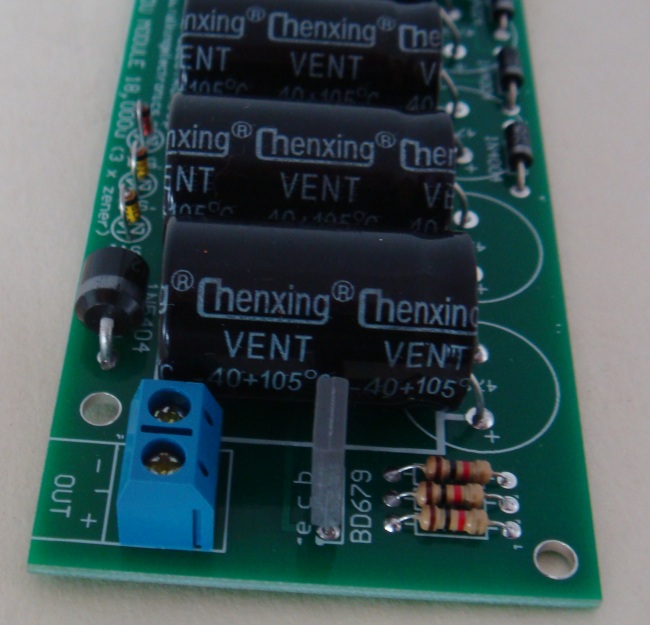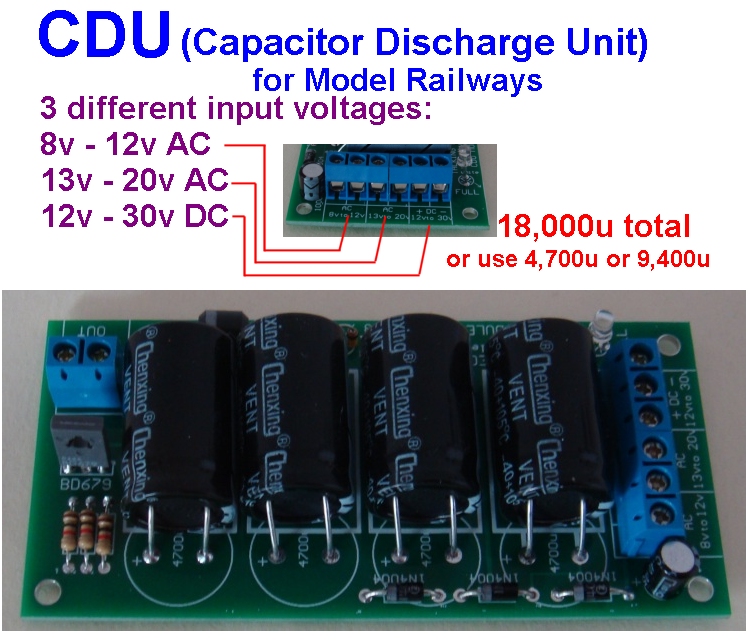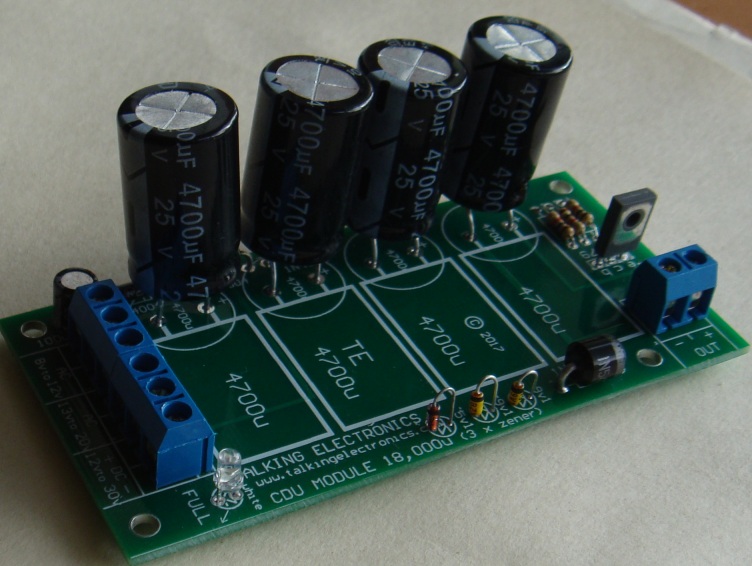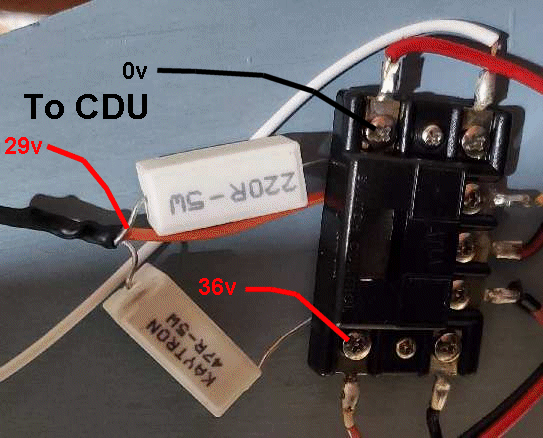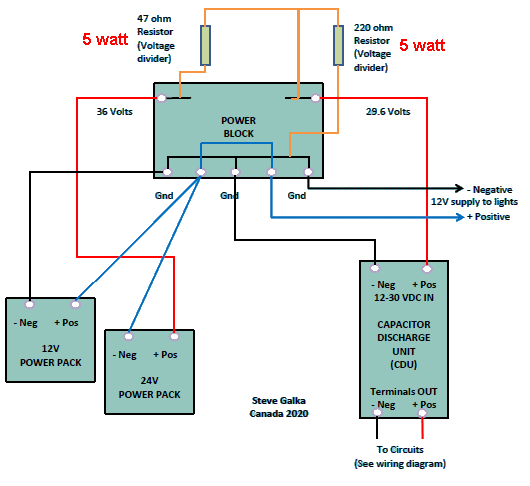|
CAPACITOR
DISCHARGE |
Capacitor Discharge Unit
18,000u kit is available from
Talking Electronics for $14.50 plus $6.50 postage.
Click HERE
for details.
This module is also available fully built and
tested for $18.50 plus $6.50 postage
![]()
This is the most powerful unit you can get and it
will switch a number of points at the same time.
The Capacitor
Discharge Unit 18,000u circuit TYPES OF ADAPTORS
It has been designed to satisfy all those who want a very powerful unit.
Just because the unit has 18,000u, does not mean it will deliver a higher
current than the 2,200u unit. The current will be almost the same, but it will
deliver the current for a longer period of time.
In addition, if you have a number of points connected in parallel, they will all
get a portion of the energy.
Every model railway has points.
Many of these points are switched remotely due to their distance from the operator
or inaccessibility in tunnels etc. Their method of control is usually
electrical and up to now a number of problems have been associated with these
circuits. They had the tendency to overheat the solenoid and even burn it
out if the signal to the solenoid is not switched OFF immediately the point has
been changed.
The
control of a set of points is simple. Electrical energy is converted to
mechanical movement via a solenoid actuator. This device is called a 'POINT
MOTOR.' They are mounted under or near the point in such a way that the
movement sets the blades of the points for one direction or the other.
This involves a linear movement of about 5mm (1/4in). To create this movement, the simplest
device is the solenoid. It is simply a coil of wire wound on a former. Inside
the former is an iron actuator or armature which can be pulled into the coil when
the power is applied. By placing two of these coils end-to-end, a forward and
reverse motion can be created. These arrangements are called 'Switch Machines'
or 'Point Motors'.
These
two-solenoid point-motors are usually switched by short pulses of electricity.
The pulse length is often determined by the operator or by a simple
spring-loaded switch.
But there are several problems with this arrangement. Point motors require a
considerable amount of current for their operation. This means the full
capacity of the transformer will be needed. Any other items using the same
supply will suffer.
There are other problems too. The high currents will play havoc with switches. The
back emf (reverse voltage) generated by the solenoid is sometimes sufficient to
weld the switch closed. This will keep the current flowing through the solenoid
and it will overheat very quickly.
Our CAPACITOR DISCHARGE UNIT overcomes all these problems.
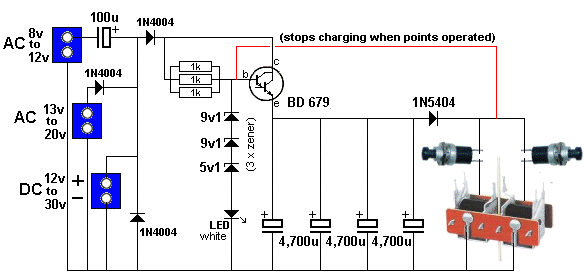
We have called it 18,000u CDU to identify it from our
other Capacitor Discharge Units.
Capacitor Discharge Units (CDU's) supply a high current 'burst' to the solenoid. This
current burst is over by the time the switch contacts open, thus eliminating
back emf across the switch contacts, Should a solenoid be left in circuit, the
current flowing through it (after the initial surge) will be less than 50mA. It
won't even be enough to warm the coil!
THE POWER SUPPLY
The CDU requires an input voltage and this is called THE SUPPLY.
One of the advantages of a CDU is the ability for it to deliver a high
current to a point motor to make sure it operates correctly.
A point motor is a solenoid and it has a resistance of less than 5
ohms. This means the current it will draw on 12v is nearly 2.5 amps.
If it is left activated for more than a second, it will get very hot as it
is consuming about 30 watts. The CDU prevents this from happening. It only
activates a point motor for half a second.
The other advantage of the CDU is it delivers this current from a supply that
can be rated at 100mA to 3 amps. If the supply is only capable of 1 amp, it
cannot be used reliably to operate the point and a 100mA supply cannot
operate the point motor directly.
This project allows a wide range of supplies to be used.
The circuit will accept either an alternating voltage (called AC) or a "battery voltage"
(called DC - Direct Current).
It effectively multiplies (increases) the current by charging the capacitors
over a long period of time at about 100mA and then provides a current of
about 2.5 amps over a shorter period of time.
Since the current required by the CDU is very small, any type of supply from 100mA to 1 amp can be
used.
The electrolytics charge-up and store the energy. It is then released in a
short burst and this changes the "point."
Almost all the adaptors you will have in your possession will be the
type called DC. However you may have a train transformer
with an AC output and this project will accept either.
The project monitors the voltage on the capacitors and prevents it
rising above 25.5v by using zener diodes that "remove" the fist 23v and the
next 3.2v is used to illuminate a LED and the charging current goes to this LED. This allows a voltage up to 30v to be supplied and the
circuit stops the charging when the capacitors reach 26.5v. The voltage drop across the
two base-emitter junctions of the Darlington transistor equal 1.4v and when this is subtracted from
26.5v, the result is about 25v. This is theoretically the maximum voltage across
the electrolytic after being fully charged.
3 separate inputs are provided and you need to select the correct input so
the circuit will charge the capacitors correctly. It converts the
voltage if it is AC (to DC) and ceases charging the capacitors when
they reach 25.5v.
This project needs a minimum supply of
about 12v AC or 16v DC and a current of about 100mA.
This means a small power supply can be used and some are rated at 200mA and
500mA.
To get a voltage of 17v, you can use a 5v adapter and 12v adapter and connect
the output as shown in the following diagram:
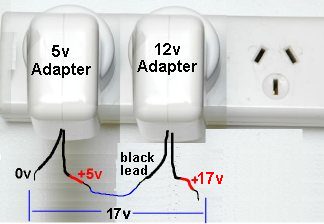
These are two DC
adapters
A Plug Pack, Wall Wort or Adapter is the best as it is completely sealed and
the output is insulated and isolated from the mains.
These are cheaper than making your own power supply and you can use some of your
(discarded) 5v adapters from your old-model phones. You can connect three to get
15v.
Make sure the wiring is
connected so the voltages are ADDED to the output. Even 300mA, 500mA and 1 amp
adapters can be connected as we are only requiring 200mA.
You can do the same with AC adapters and although the output is changing many
times a second, the output wires have to be connected so they ADD to the output.
Connecting them the wrong way with produce ZERO output.
You can connect adapters of different voltages and current and even AC and DC
adapters as the circuit will accept all these variations. You can connect an AC
adapter either way around to a DC adapter and it will produce AC of the combined
voltage for the first half-cycle and zero voltage for the second half-cycle.
This is a good project to use-up those discarded adapters.


